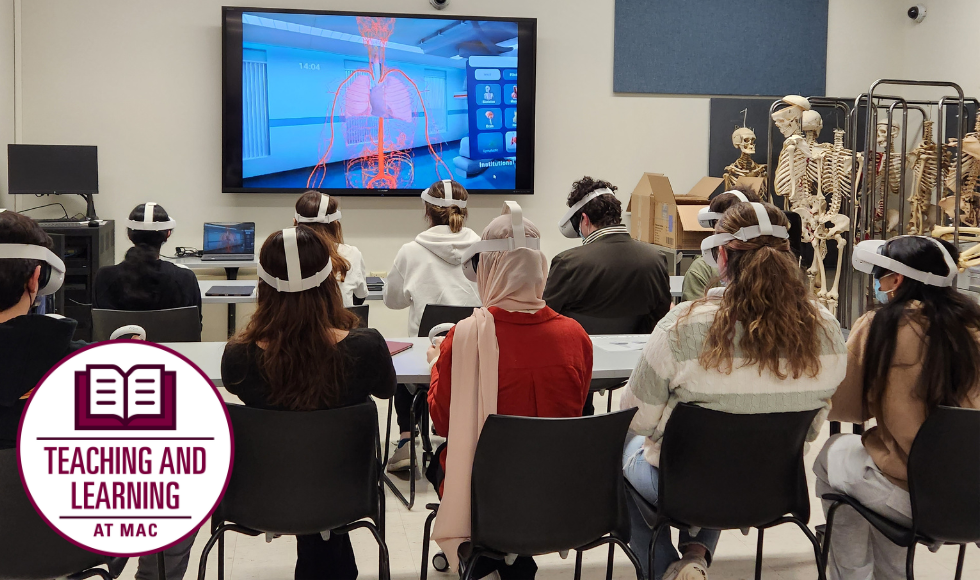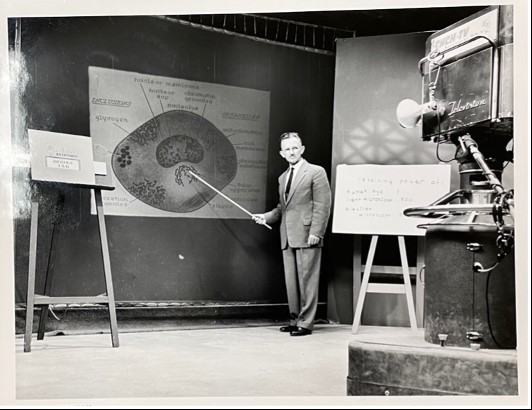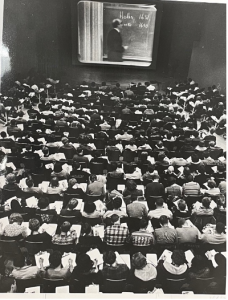McMaster launches Digital Learning Strategic Framework

Students in Ilana Bayer’s class learn about anatomic structures using virtual reality. The assistant professor of Pathology and Molecular Medicine regularly uses technology to teach anatomy.
Students in Professor Ilana Bayer’s class often use virtual reality to study anatomy. In fact, Bayer uses technology in all her courses.
“It’s difficult to appreciate anatomic structures and the relationships within when you look at a cadaver or two-dimensional image,” says Bayer, an assistant professor of Pathology and Molecular Medicine, whose students also learn about patient flow and digital tools in a simulated emergency room.
“To me it’s not about just doing things online, it is about enhancing our teaching and learning activities.”
More than six decades after securing its first computer, McMaster University has launched a strategic framework for digital learning that gives instructors a guide to improve the learning experience for students.
The Digital Learning Strategic Framework, announced May 8, addresses the need for a centralized philosophy for digital learning and offers a coordinated approach for online tools and technologies and a plan for implementation.
“By investing in digital learning, McMaster is ensuring that our graduates have an understanding of the tools that are now involved when decisions are made about important issues such as public health and democracy,” says Kim Dej, vice-provost, Teaching and Learning, whose office led its development.
The framework, which is part of the overarching Partnered in Teaching and Learning strategy introduced in May 2021. equips students with essential digital skills for being engaged citizens, Dej says.
“The framework also provides much-needed institutional support for our instructors, many of whom have been incorporating digital tools into their teaching for years.”
It’s the product of two years of faculty and staff consultations with students and other campus partners to enhance and complement the face-to-face learning experience at McMaster.
“We recognize that technology is now integral to teaching and learning. We are all living, studying and working in a digitally-enhanced environment and that’s not going to change,” says Susan Tighe, provost and vice-president (Academic).
“McMaster’s Digital Learning Strategic Framework helps prepare students for the future of work and for connecting with researchers, communities, industry partners and future employers around the globe.”
Digital Learning in Action
When and how to use technology is driven by learning expectations and program outcomes. Instructors know which technologies work in their courses and they receive encouragement and support for innovation and experimentation.
Instructors also collaborate with colleagues and program leads to determine how the use of technology fits into curriculum delivery at the program level.
Michael Wong, assistant professor of Psychiatry and Behavioural Neurosciences, used technology to create a virtual exchange with students and researchers at Universidad San Francisco de Quito (USFQ) in Ecuador.
“The students in Ecuador were in a brain and behaviour course. I teach a neuroplasticity course, so there was a natural alignment between the two,” Wong says.
“The students in Ecuador were focused on how the brain functions in relation to behaviour, whereas my students take that information and think about interventions. Pairing our two institutions was a great learning opportunity for both.”

 Online teaching allows associate professor Peter Cockett from the Faculty of Humanities to teach Theatre and Film Studies to large classes, bringing 300 students “to the front of the classroom.”
Online teaching allows associate professor Peter Cockett from the Faculty of Humanities to teach Theatre and Film Studies to large classes, bringing 300 students “to the front of the classroom.”
“By teaching online, I can perform up close to my students,” he says.
“The chat function online was a great tool for engagement. Students could post their responses without the fear that comes from speaking up in class. I could review multiple responses from all students who wanted to share their perspective, and respond to the most pertinent, rather than selecting one or two students to answer the question live in the classroom.”
A framework for inclusive student success

Digital tools allow students to participate in discussions that might have been daunting in person, says Tuqa Al-Rammahi, a fourth-year Political Science student specializing in Public Law and Judicial Studies.
“People assume that I’m not shy because I’m president of the McMaster Social Sciences Society, but I’m shy academically,” says Al-Rammahi, who was part of the consultations that led to the Digital Learning Strategic Framework.
“I find it hard to participate in some discussions, so I really appreciate it when instructors also use online discussion posts, polls and jamboards.”
Everyone arrives in university with varying experiences of using tech, she notes, so the framework will help provide unifying guidance.
The framework also encourages the use of digital tools to improve accessibility, says Kate Brown, accessibility program manager for the AccessMac Program.
“Technology has the potential to make our university more inclusive for everyone,” Brown says.
“It can be used to reduce or remove some barriers to learning, such as inaccessible course materials, family and personal challenges, transportation issues and physical classroom impediments.”
Digital Learning is About People
The framework will be successful in contributing to teaching and learning excellence because it is people centred, Dej says.
“McMaster has committed to invest in staff, time, and resources to provide both educators and learners with high quality experiences,” Dej says. “We want our people feeling confident and comfortable using digital teaching and learning tools. Think of it this way. It is not just tech support, but also human support.”
Learn more about McMaster’s Digital Learning Strategic Framework on the Office of the Provost’s website.

